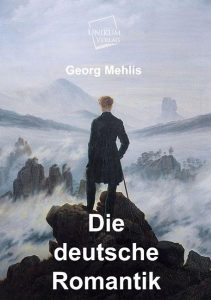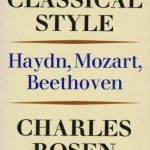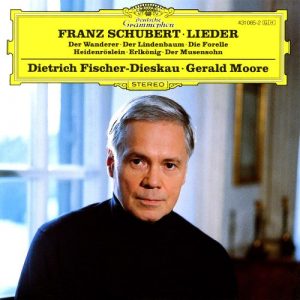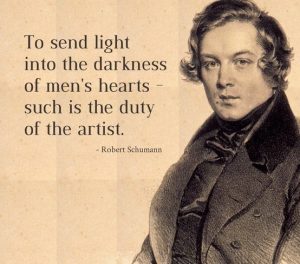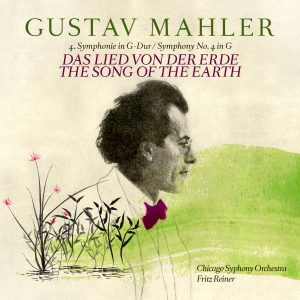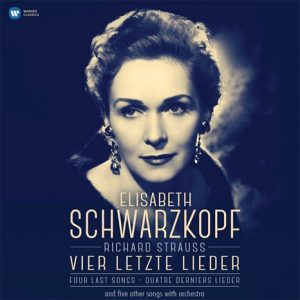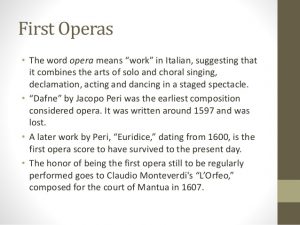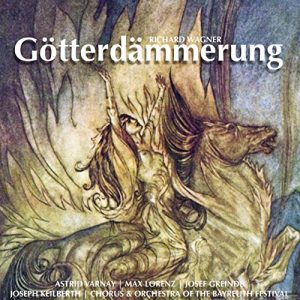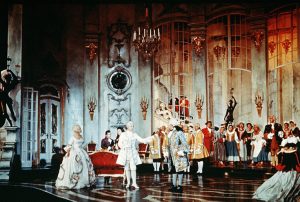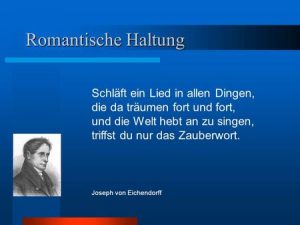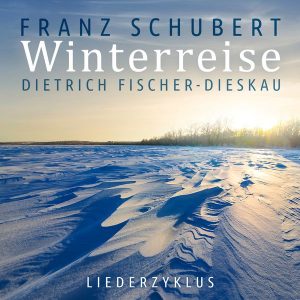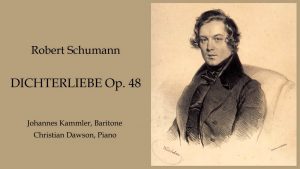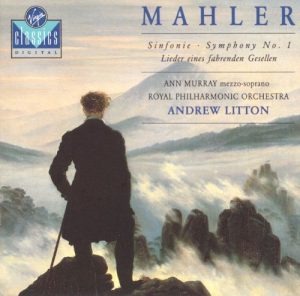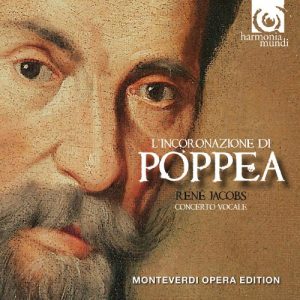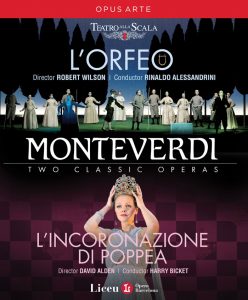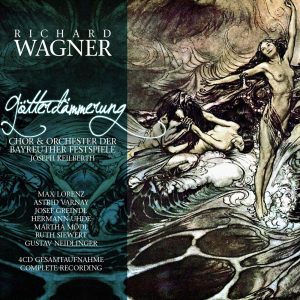Musik und Oper der deutschen Romantik
Pauline Park
Man kann nicht von der romantischen Ära ohne Musik sprechen; bestimmt hat die deutsche Romantik sich durch Romane une Poesie und Malerei ausgedrückt; aber Musik hat eine zentrale Rolle in der Romantik gespielt, besonders in der deutschen Romantik und Oper in der romantischen deutschen Musik.
Symphonien, Kammermusik, Lieder und Opern sind alle wichtig in der Musik der deutschen Romantik. Franz Joseph Haydn hat durch seinen Sonaten und Symphonien und Streichquartetten den klassichen Stil geschaffen und Wolfgang Amadeus Mozart und Ludwig van Beethoven hatten mit ihren Sonaten, Symphonien, Kammermusik und Opern diesen Stil weiterentwickelt und perfektioniert. Beethoven und Franz Schubert waren Transitionsfiguren zwischen dem klassischen Stil und der Romantik.
Aber es ist das Element der Poesie, das Lieder und Opern in der Entwicklung der deutschen Romantik besonders wichtig macht. Um die deutsche Romantik zu verstehen mußt man über alles deutsche Lieder und deutsche Opern sprechen. Komponisten hatten Lieder vor der Romantik komponiert; und deutsche Komponisten hatten Lieder auf deutsche Gedichten komponiert. Ein Beispiel wäre “Adelaïde” (op. 46, c. 1795) von Beethoven ist ein kleines Meisterwerk! Aber die Lieder von Haydn, Mozart und Beethoven sind nicht zentral im Oeuvre der Komponisten der klassischen Ära.
Wenn Schubert als der wichtigste Lieder-Komponist der Frühromantik und Schumann der ‘hohen’ Romantik gelten, so repräsentieren Gustav Mahler und Richard Strauß die Spätromantik. Mahler hat fünf Liederzyklen geschaffen: “Das klagende Lied,” “Des Knaben Wunderhorn,” “Lieder eines fahrenden Gesellen,” “Kindertotenlieder” und die “Rückert Lieder.” Mahler hat auch eine Symphonie geschaffen die “Das Lied von der Erde” heißt. “Ging heut’ morgen über’s Feld” (“Lieder eines fahrenden Gesellen”) drückt das romantische Gefühl perfekt aus: in diesem Lied hört man die Liebe, den Herzschmerz und die Natur. Aber “Das Lied von der Erde” ist ein einziges Meisterwerk und “Der Abschied” berührt einen mit einer Tiefe des Gefühls, wie der Komponist sich vom Leben verabschiedet, während er die lebensspendende Erde umarmt.
Richard Strauß ist der einzige deutsche Komponist, der sowohl in den Liedern als auch in der Oper herausragend ist. “Ständchen” (1887) und “Morgen” (1894) sind kleine Meisterwerke und die “Vier letze Lieder” sind das außergewöhnliche Ende seiner gesamten musikalischen Karriere. Das zweite Lied (“September”), das dritte (“Beim Schlafengehen”) und das vierte (“Im Abendrot”) gehören zu den schönsten Liedern, die je geschrieben wurden. “September” und “Beim Schlafengehen” sind Gedichten von Hermann Hesse und “Im Abendrot” ist ein Gedichte von Joseph von Eichendorff. Die drei letzten Lieder dieses Liedzyklus sind vielleicht die tiefgründigsten musikalischen Vertonungen der tiefsten poetischen Texte, die jemals geschrieben wurden. Und diese drei letzte Lieder von Strauß Diese drei letzten Lieder sind der Kulminationspunkt der musikalischen Romantik. (Eigentlich hat Strauß das Lied “Malvern” später geschrieben aber niemand hält es für ein wichtiges Werk.)
Natürlich ist Musik eine alte Kunst und vielleicht hat die Musik der Sprache vorangegangen. Aber die Oper als Genre reicht vor das Jahre 1600 zurück. Die Oper beginnt 1597 mit “Dafne” von Jacopo Peri aber die Musik dieser Opera ist nicht überliefert. Die Musik der “Euridice” von Jacopo Peri und Giulio Caccini ist überliefert aber die erste Oper die aufgeführt wurde, ist “Orfeo” von Claudio Monteverdi. Ich habe eine prachtvolle Inszenierung von dieser 1607 komponierten Oper in London gesehen. Monteverdi ist die wichtigste Transitionsfigur zwischen der Renaissance und dem Barocke und die letzte Oper Monteverdis “L’Incoronazione di Poppea” (Die Krönung Poppeas) hat das Genre Barockoper begründet.
Klassischen Opern sind die von Franz Joseph Haydn, Wolfgang Amadeus Mozart und Ludwig van Beethoven aber vor allem die Opern von Mozart der zwar nur zwei deutsche Opern komponiert hat: “Die Entführung aus dem Serail” (1782) und “Die Zauberflöte” (1791). Beethoven hat nur eine Oper komponiert: “Fidelio” (1805). Aber die deutsche Romantik beginnt in der Oper mit Carl Maria von Weber. “Der Freischütz” (1821) ist der Grundstein der deutschen romantischen Oper. Der Rationalismus triumphiert am Ende über Mozarts Oper “Die Zauberflöte” weil diese Oper der höchste Ausdruck der deutschen Aufklärung darstellt. Aber “Der Freischütz” handelt nicht vom Rationalismus sondern von dessen Gegenteil: in dieser Oper findet man sich nicht in Sarastros Tempel der Vernunft sondern in einem dunklen Wald mit dem Teufel~! In der Welt der Oper Webers ist die Zauberei nicht unterhaltend, sondern gefährlich. Das Volk spielt eine bestimmte Rolle und das Volk hier ist vor allem das *deutsche* Volk; und aus diesem Grund ist “Der Freischütz” derart beliebt in Deutschland. Das Volk sind hier die Bauern der Märchen der Gebrüder Grimm, da diese Oper in der Zeit der Gebrüder Grimm geschaffen wurde. Die Freikugeln die Kaspar Max anbietet, sind Zauberkugeln des Teufels (der hier Samiel heißt); darum sind diese Freikugeln ein Teil eines faustianischen Pakts, der ihn in die Hölle Max schicken konnte und seine Geliebte töten kann. Die Wolfsschluchtsszene fängt und verkörpert die Essenz der deutschen Romantik als ein Gemälde Caspar David Friedrichs. “Der Freischütz” ist das Meisterwerk Webers und hat Richard Wagner und alle deutschen romantischen Komponisten beeinflußt.
Weber ist auch der Vater der nationalistischen Oper. Nach Weber hat Giuseppe Verdi die nationalistische Oper in Italien mit “Nabucco” geschaffen (1841); der Chor der hebräischen Sklaven drückt die nationale Bestrebungen des italienischen Volkes aus; mit “Nabucco” wurde Verdi der Komponist des Risorgimento (die Bewegung für die Befreiung Italiens von der österreichischen Herrschaft). “Der Freischütz” beeinflußte jeden deutschen romantischen Komponisten nach ihm, aber vor allem Richard Wagner, der in Deutschland der Nachfolger von Weber war.
Man spurt den Geist des Mittelalters in den Opern Richard Wagners, besonders “Lohengrin” und “Tannhäuser.” Mit “Tristan und Isolde” daß die Spätromantik in Oper beginnt. Aber es ist “Götterdämmerung” — die vierte und letzte Oper des Ringzyklus — ist die längste Oper im Repertoire ist. Germanische und nordische Mythologie haben Wagner inspiriert den “Ring des Nibelungen” zu schaffen und die vier Opern des Ring-Zykluses zusammen sind das längste Werk aller Opern. Dieser Ring-Zyklus demonstriert das Phänomen der Verlängerung von musikalischen Linien und Formen ebenso wie deren Fragmentierung, was so typisch für die frühromantischen Komponisten wie Schubert und insbesondere Schumann ist. Die Musik der Szene “Siegfrieds Rheinfahrt und Trauermasch” von der “Götterdämmerung” hat eine außergewöhnliche Kraft, die sozusagen einzigartig in Oper ist.
In den vor Opern Richard Strauß findet man diese Verlängerung von musikalischen Linien vollendet wieder. Frédéric Chopin bewunderte die ‘himmlische Länge’ der Arien von Vincenzo Bellini und wurde von ihnen beim Schreiben seiner Klaviermusik stark beeinflußt — z.B., die Arie “Casta Diva” von der Oper “Norma.” In den Opern von Richard Strauß — z.B., “Ariadne auf Naxos” und “Arabella” und “Der Rosenkavalier” — hört man unglaublich lange musikalischen Linien; die ‘Präsentation der Rose’ Szene in “Rosenkavalier” is vielleicht die höchste Beispiel dieses Phänomenes; die Phrasen von Octavian und besonders Sophie schweben über dem Orchester und scheinen zeitweise in der Luft weiterzuschweben in einer musikalischen Zeitlosigkeit. Strauß hat viele andere Opern geschrieben, aber meiner Meinung nach sind das letzte Trio und Duett des “Rosenkavaliers” der Kulminationspunkt und der letzte und schönste Ausdruck der deutschen romantischen Oper. Die Opern von Strauß bilden sowohl den Schlusspunkt der deutschernromantischen Oper als auch Lieder.
One cannot speak of the Romantic era without mentioning music; Romanticism was certainly expressed through novels, poetry and painting, but music played a central role in Romanticism and opera played a central role in Romantic German music.
Symphonies, chamber music, songs and operas were all important in the music of German Romanticism. Franz Joseph Haydn created the classical style through his sonatas, symphonies and string quartets and Wolfgang Amadeus Mozart and Ludwig van Beethoven advanced and perfected that style through their sonatas, symphonies, chamber music and operas. Beethoven and Franz Schubert were transitional figures between the classical style and the Romantic.
But it is the element of poetry in art songs and operas that makes them especially important in the development of German Romanticism; hence to understand it, one must discuss German Lieder and opera above all. Composers had composed Lieder before the Romantic era and German composers had composed Lieder to German poems before. “Adelaïde” (op. 46, c. 1795) of Beethoven is a miniature masterpiece; but the songs of Haydn, Mozart and Beethoven are not central to the oeuvre of the composers of the classical era.
Franz Schubert changed everything; for the first time in the history of music, the genre of the ‘art song’ had become ‘high art’ and had come to occupy a central role in the oeuvre of a great composer. Schubert died at an earlier age than any of the other great composers yet wrote more than 600 songs in his short life. Schubert was only 31 when he died; but before his death, he completed seven symphonies and hundreds of works of chamber music. But it is in the Lieder repertoire where Schubert reigns supreme. There are songs written in a more restrained manner and others that fully express Romantic ‘Gefühl’ (feeling); “An die Musik” (D.547, 1827) is an example of the former; “Kennst du das Land?” (D.321) ist an example of the latter.
“An die Musik” (1827) is a hymn to music, almost religious in feeling. “Mignons Lied” (1815) begins with a question — with the words “Dahin! Dahin! Möcht’ ich mit dir, o mein Geliebter, ziehn” (There! There! I would like to go there with you, o my beloved) — expresses Romantic Gefühl. Schubert Lieder are little operas but the drama is internal: there are no gestures, no costumes and no stage — only the voice. Eight composers have set this text of Johann Wolfgang von Goethe but only the settings of Schubert and Schumann are often performed.
And Robert Schumann is after Franz Schubert the most famous composer of German Lieder. Schubert created the genre of the ‘Liederkreis’ (song cycle): “Die schöne Müllerin” (The Beautiful Miller’s Daughter), “Winterreise” (Winter’s Journey) and “Schwanengesang” (Swan Song). After Schubert, Schumann created his own song cycles: two are simply called “Liederkreis” — Op. 24 based on the poems of Heinrich Heine and Op. 39. to texts by Joseph von Eichendorff. In the songs of the two “Liederkreise,” one finds beauty and Romantic ‘Gefühl’ expressed in fragments; both Liederkreis song cycles were written in Schumann’s ‘Liederjahr’ (‘year of song’), 1840. “Ich wandelte unter den Bäumen” (I wandered under the trees) (Op. 24, N. 3), “Mondnacht” (Moonlit Night) (Op. 39, N. 5) and “Wehmut” (Melancholy) (Op. 39, N. 9) are masterpieces of the Lied genre. Schumann went further with yet two more song cycles: “Frauenliebe und -leben” (Woman’s Love and Life) (Op. 42) to poems by Adelbert von Chamisso (1830) und “Dichterliebe” (Poet’s Life) (Op. 48, 1840). “Dichterliebe” is Schumann’s most famous song cycle, a setting of the “Lyrischen Intermezzo” (Lyrical Intermezzo) of Heinrich Heine and “Im wunderschönen Monat Mai” (In the Wonderful Month of May) (Op. 48, N. 1), is the most famous song in this cycle. “Aus alten Märchen winkt es” (From Old Fairy Tales It Beckons) ( (Op. 40, N. 15) brings this song cycle into a direct relationship relationship with the fairy tales of the Gebrüder Grimm (the Brothers Grimm) — an important element in the German Romantik.
Classical opera is Franz Joseph Haydn, Wolfgang Amadeus Mozart and Ludwig van Beethoven but above all the operas of Mozart who only wrote two German operas: “Die Entführung aus dem Serail” (The Abduction from the Seraglio) (1782) and “Die Zauberflöte” (The Magic Flute) (1791). Beethoven wrote only one opera: “Fidelio” (1805); but the German Romantik in opera begins with Carl Maria von Weber. “Der Freischütz” (1821) is the foundation stone of German Romantic opera. Rationalism triumphs at the end of Mozart’s opera “Die Zauberflöte,” the greatest and finest expression of the German Enlightenment. But “Der Freischütz” is not about rationalism but rather its opposite: in this opera one finds not Sarastro’s temple of reason but rather a dark forest complete with the devil~! In the world of Weber’s opera, magic is not charming but rather dangerous; but ‘das Volk’ (the people) play an especially important role and ‘das Volk’ here is above all the das *German* Volk; and it is for this reason that “Freischütz” is beloved in Germany. The ‘Volk’ here is the peasants of the fairy tales of the Gebrüder Grimm and this opera was written in the era of the Brothers Grimm. The ‘Freikugeln’ (freeshooting bullets) that Kaspar offers Max are ‘Zauberkugeln’ (magic bullets) of the devil (here represented by the Mephistophelian character of Samiel); these Freikugeln are part of the Faustian bargain that Max makes without realizing that he is risking the life of his beloved in using them. The ‘Wolfsschluchtsszene’ (Wolf’s Glen scene) embodies the essence of the German Romantik just as the art of the painter Caspar David Friedrichs. “Der Freischütz” is Weber’s masterpiece and influenced Richard Wagner and every German Romantic composer after Weber.
Weber is also the father of nationalist opera and Giuseppe Verdi was influenced by him in helping to create nationalist opera in Italy with “Nabucco” (Nebuchadnezzar) (1841); the ‘Chorus of the Hebrew Slaves expresses the national aspirations of the Italian people; with “Nabucco,” Verdi became the composer of the Risorgimento (the movement for the liberation of Italy from Austrian rule). “
One feels the spirit of the Middle Ages in the operas of Richard Wagner, especially”Lohengrin” and “Tannhäuser.” And it is with “Tristan und Isolde” that the late Romantik in opera begins. But it is “Götterdämmerung” (The Twilight of the Gods) — the fourth and last opera of the Ring cycle — that is the longest single opera in the repertoire. Germanic and Norse mythology inspired Wagner’s “Ring des Nibelungen” and the four operas of the Ring cycle together constitute by far the longest work in all opera. This Ring cycle demonstrates the phenomenon of the lengthening of the musical lines and enlargement of musical forms even as the fragmentation of musical lines and forms is so typical of the early Romantic composers such as Schubert and especially Schumann. The music of the scene “Siegfrieds Rheinfahrt und Trauermasch” (Siegfried’s Rhine Journey and Death March) from “Götterdämmerung” has an extraordinary power almost unique in opera.
It is in the operas of Richard Strauß that one finds the perfecting of the lengthening of musical line and form. Frédéric Chopin was enchanted by the ‘heavenly length’ of the arias of Vincenzo Bellini and the writing of Chopin’s piano music was heavily influenced by Bellini — e.g., the aria “Casta Diva” (Chaste Goddess) from the opera “Norma.” In the opera of Richard Strauß — e.g., “Ariadne auf Naxos” (Ariadne on Naxos) and “Arabella” and “Der Rosenkavalier” (The Knight of the Rose) — one hears incredibly long musical lines; the ‘Presentation of the Rose’ scene in “Rosenkavalier” is perhaps the supreme example of this phenomenon; the phrases of Octavian and especially Sophie soar over the orchestra and seem almost to hang in mid air, hovering in music outside of time. Strauß wrote other operas but in my view the final trio and duet from “Rosenkavalier” is the culmination and the last and most beautiful expression of Romanticism in German opera; one can consider Strauß the end point of German Romantic opera just as he represents the culmination of German Romanticism in Lieder.
